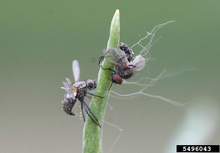No matter where extension educators have been traveling this summer, they have noticed dead flies stuck to stuff. Dead flies stuck to flowers and garlic scapes and asparagus spears and the sides of buildings. What is going on?
The likely culprit is an insect-destroying fungus. The name of the fungus, Entomophthora, means “insect destroyer.” There are several species of this fungus, and they are often specific to the kind of insect they kill. There is a strain that targets grasshoppers, reducing their numbers in wet years. The fungus that attacks house flies (Musca domestica) is called Entomophthora muscae.
If you’ve seen these dead flies attached to flowers or even stuck on a window, you may have noticed that their bodies look puffy and distended. This is because, after airborne fungal spores land on a fly, they grow inside the fly, making the insect large and puffy.
Once inside a fly, the fungus grows into the fly’s brain, causing a distinct change in behavior, often called “summit disease.” Instead of acting normally, the fly crawls upwards as high as possible, going to the top of the surface it’s on (“summiting” a stalk of grass, for example). This change in behavior also comes with the formation of specialized fungal structures that help the fly stick itself to the surface with extended mouthparts.
Before it dies, it spreads its legs, stretches its wings, and angles its body outward. The elevated location and opened-up posture improve the chances that fungal spores will leave the dead fly body and infect new hosts.
This particular fungus can also be spread another way. Male house flies are attracted to dead females with the fungus and can become exposed to the fungal spores when attempting to mate with the deceased females.
Sometimes the natural world is stranger than science fiction!


